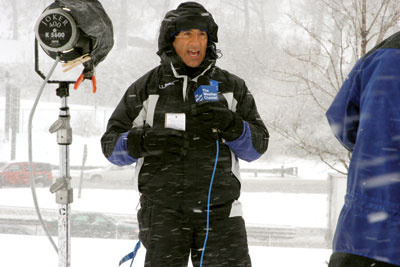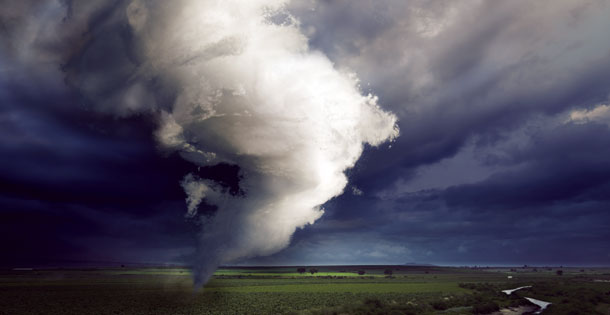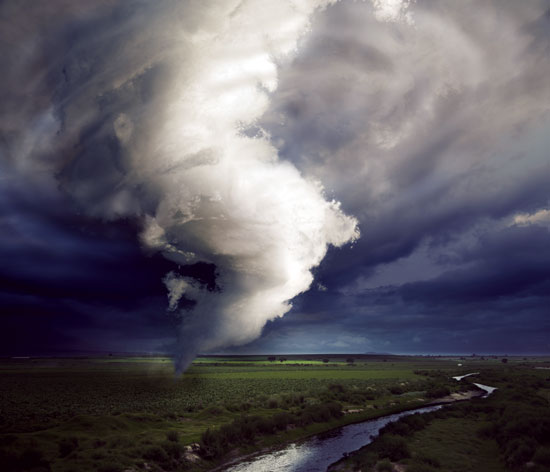JUST WHY DOES JIM CANTORE RISK LIFE AND LIMB TO REPORT LIVE FROM THE FRONT LINE OF SEVERE WEATHER EVENTS?
His answer is simple: “I want the ball.” For The Weather Channel storm tracker, famous for being buffeted, pelted, and drenched on the air, confronting a hurricane or blizzard is like suiting up for the big game. “When you’re in the Super Bowl, you want to score the winning touchdown, catch the winning pass, kick the winning field goal,” he explains.
Score one for the weather team. In Cantore you have science and show business all wrapped up in one spiffy Gore-Tex package. A highly trained, telegenic broadcast meteorologist facing down danger in HD in order to inform and protect you and me. And according to his boss David Kenny, the CEO of The Weather Company (The Weather Channel is one of many “brands” under The Weather Company umbrella, but more on that later), that’s exactly what Americans now want and expect.
“People want to see what’s going on. They don’t want the map,” he says. “They want to feel the power of the weather.”
Folks, we’ve come a long, long way from forecasts drawn with markers on plexiglass over a Rand McNally map. “Technology has brought the weather into our living rooms,” says Cantore. “Now you’re watching it in high-definition, unthinkable images. That’s what weather is today: the quintessential reality TV.”
In other words, it’s entertainment. Albeit, entertainment with life and death consequences for those sitting in the path of a Category 4 hurricane or an EF5 tornado. A hybrid of entertainment and public service that seemingly weather-obsessed Americans can’t get enough of these days. And for good reason, suggests Kenny: “It’s storytelling, and weather stories have a kind of drama, a contest between man and Mother Nature. People are interested in that. They want the humans to win.”
IN HIS DELIGHTFUL AND INSTRUCTIVE Weather Book, the late Eric Sloane wrote, “The weather is with us wherever we are, yet nothing is more taken for granted than the daily drama of the sky.” Sloane was spot-on about the ubiquity of weather in our lives. From what to wear to when to plant, the morning commute to the price of food, weather affects us in myriad ways in the short term and the long term. But Sloane was writing in 1949, the dawn of television meteorology, and his second observation, that nothing is more taken for granted, doesn’t hold true today.
Perhaps you’ve noticed how the weather almost always leads the local news; how it is promo’d during the broadcast day and in between scheduled programs; how on the morning, noon, evening, and night news the forecast is dished out in two-minute increments, like appetizers, amid the rest of the hour’s reports; how meteorologists withhold the complete seven-day forecast until the end of the show (“more on that in just a few minutes”), all the while animatedly tracking and analyzing pressure fronts and precipitation from every angle and direction on chroma-keyed color Super Doppler radar graphics that shift back and forth behind them. It may be a sunny day without a cloud in the sky, and half the news program is still devoted to the weather.
Not surprisingly, there’s a reason for this beyond a simple desire to keep the viewers informed. The television business is a constant quest for eyeballs, and weather delivers them. “We know from research all across the country that weather content is a key driver for consumption of news of any kind,” says Laura Clark, senior vice president at Frank N. Magid Associates, a prestigious consulting firm that has advised local and national media for 57 years. “Of course, severe weather is even more of a driver.”
Which means, if it wasn’t for weather, local news programs could find themselves tanking in ratings. But it’s not as though viewers were coming for the news anyway; weather was the top reason given for tuning into local news 80 to 90 percent of the time in a Magid study. What’s more, a station’s chief meteorologist can be the most popular talent on the air, with a large, loyal following, especially in markets along Tornado Alley or the Gulf Coast, where weather can be life or death. All good reasons to keep those long-range forecasts and cutting-edge graphics coming, and coming, and coming.
AS IT IS, LOCAL NEWS STATIONS and weathercasters are scrambling to keep up with the times and demand. Thanks to digital technology, the means of accessing and delivering the weather are changing, expanding. Nowadays, there are websites, smartphones, mobile apps, blogs, YouTube, Facebook, Instagram, and Twitter, all being employed to satisfy a seemingly unquenchable demand for weather news.
Nobody understands this better than James Spann at ABC 33/40 in Birmingham, Alabama. An Emmy Award-winning broadcast meteorologist who was named Broadcaster of the Year by the National Weather Association (NWA) in 2012, Spann has covered severe tornadoes, hurricanes, and floods in his 35-year television career. He also now blogs, tweets, and hosts a popular weekly podcast, WeatherBrains. “The times have changed–just like the print business–so we have to deliver weather across a variety of digital platforms in different ways,” he says.

Photo courtesy The Weather Channel
According to Spann, the ABC 33/40 Weather Blog has “gone over 2 million page views in a 24-hour period multiple times.” In addition, he boasts 124,435 Twitter followers and 149,112 Facebook “likes.”
“There’s a really good chance that I’m reaching more people on social media than television on a normal day, which is mind boggling,” he says.
“If you’d told me that five years ago, I would have said you’re crazy.”
Here’s another number to consider: 300 billion. According to a nationwide survey conducted in 2006 and released in 2009 by NCAR (National Center for Atmospheric Research) in Boulder, Colorado, adults in America obtain an estimated 300 billion weather forecasts, an average of 3.8 forecasts a day per person. “What we found is that weather permeates almost everybody’s lives, it is kind of like an infrastructure,” says project lead Jeff Lazo. “Weather information is a fundamental thing, we use it multiple times every single time. So it really is ubiquitous.”
Now keep in mind that this survey was conducted in 2006, before the boom in smartphones, apps, and social media. “We didn’t ask them about Twitter and Facebook and stuff, because those didn’t really exist as much then,” says Lazo. Aware that a sea change was underway, NCAR conducted a second survey in 2010. NCAR associate scientist Julie Demuth is currently crunching the numbers on that report, but she ventures that it’ll show a definite uptick in the use of smartphones and the like to obtain forecasts.
As the weathercaster would say: Stay tuned for that report. It should be an invaluable window into our weather-watching habits.
SO, WHAT IS IT WITH AMERICANS AND WEATHER? How did it become a life-and-death entertainment, a mix of science and show business that enthralls us, the ultimate reality television, an indispensable part of our lives? Let’s step into the Wayback Machine for a quick whirl through weather, American style.
Purchase the digital edition for your iPad, Nook, or Android tablet:

To purchase a subscription to the print edition of The Saturday Evening Post: 
Become a Saturday Evening Post member and enjoy unlimited access. Subscribe now




